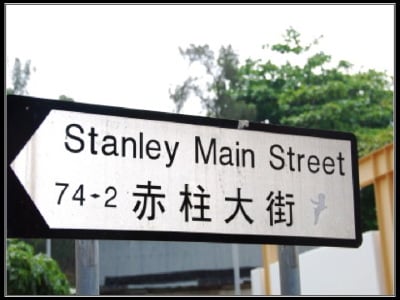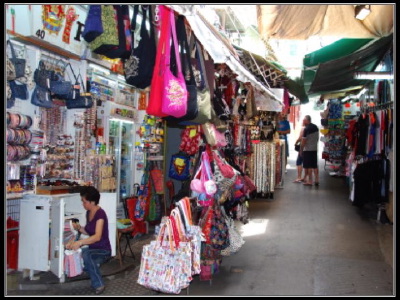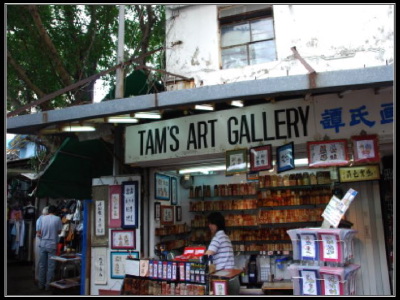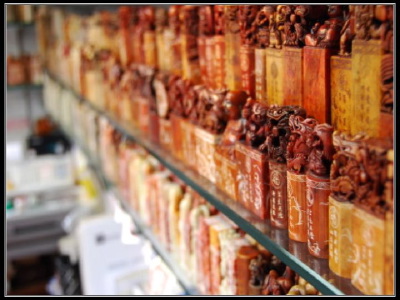A little while ago I was in Hong Kong to make a speech. I visited Stanley Market,—a large bazaar (nothing to do with the Stanley Cup). Mind you, it’s a kiosk compared to the Grand Bazaar in Istanbul, but it’s jammed with stores.
Most of the stores carry a little bit of everything: tshirts, shoes, consumer electronics, leather goods—you name it.
After spending an hour there, I bought something from only one store: Tam’s Art Gallery. This store specializes on making “chops” (seals). You provide the English word, and the employee makes a chop with the Chinese characters.
This is a small part of the store’s selection of chops. Other stores sold similar chops, but only as part of a mashup of many items.
I relearned a marketing lesson here: Do one thing right. Tam’s positions its product offering and thereby helps its customers make a purchase decision. All the other stores offered too much and made a product decision more difficult. Granted, it may take you a while to figure out what the one thing is (for all I know, Tam’s started off sellling a bunch of stuff too), but businesses should strive for standing for one thing in their customer’s minds.






Sort of like a Walmart vs Barnes & Nobel approach for books wouldn’t you say? Many people try to become the equivalent of everything but that market is over-saturated… I agree, specialization is the key!
Jon
I live in HK and Stanley is great. You can find almost anything from chops to silks to swords, all at a wonderfully negotiable price.
Interesting post Guy, as Tom Peters would say: “Stick to the knitting”. Like the photos by the way they really add to the message of the post.
Funny. I experienced the same some years ago, and bought a stamp.
One of the key rules for a salesman is to convey the most simple yet convincing message to his prospect. Thus the necessity to focus on the one need as stated by the prospect himself or as you found out discussing with her.
That is part of the ” customer interview ” game.
I agree that it is much easier to position yourself as a business by excelling in one area rather than being a “jack of all trades”, however here is an interesting example of specializing and offering a wide variety of products at the same time: Ranking RanQueen (www.ranking-ranqueen.net), a Japanese business that “imposes scarcity” in a world of abundance differentiating itself as a business in an innovative way. They do this by offering an assortment of products, but restricting the consumer’s choices to only the most popular items in a given category. I first came across this on Dan Pink’s blog. Check out this URL for a write-up: http://www.danpink.com/archives.php. The article is entitled, “Good design in Japan-Example 5”.
While I agree that a defined and narrow niche is good. Getting enough visitors/customers can be a marketing problem.
Michael
Great photos Guy. Thanks! I especially like the close up of the row of chops.
Cyrus
http://blog.uible.com
I was there too, a few years back and bought 5 chops for family members. I was untresting that I was also pulled more towards the stores that concentrated on one market type…
Justin – Thanks for the link to www.danpink.com and the forced scaricity example in Japan. Would love to have a store like that in US. There have been market research studies where a greater % of customers chose to buy when they had to choose among three items vs. 20 items.
My Marketing & usability mantra: “Choice is the enemy of decision”. Perfect example huh Guy?
Hi Guy,
I love to read your posts. Simple. Straight. Meaningful.
We know this, but still reminds us “Specialization is good for value”.
Rajesh Shakya
http://wwww.rajeshshakya.com
Helping Technopreneurs to excel and lead their life!
Just to play the devil’s advocate for a minute… the easiest way to make a sale is to sell more to existing customers as supposed to trying to land new customers. In a situation like the Stanley Market where many of the people who come to the stores are first time visitors, it makes sense to focus on one thing and not distract your potential customers.
However, in other businesses where you have a trusted relationship with existing clients it is easy to increase your sales by selling them additional products or services that will fill their needs.
Obviously you need to ensure the quality of the new offering you are selling and it should be aligned with what your current customers know you for ie. if you sell computers don’t try to sell them gardening services.
I think the strategy of selling only one thing and doing it well can work in some industries but it’s worth looking at expanding as you develop a loyal following of customers.
We love reading your posts Guy. We specialize in only one thing: cookies. But the repeat orders come in from customers since they can make them their “own”. And I think they like the creativity of it. We won’t be expanding to brownies or muffins anytime soon, just cookies since it seems to be working.
Love your site!
Warm regards,
When-Dee Morrison
Owner, Fat Cookie
www.fatcookie.com
Great post Guy!
I love the idea of streamlining your products and services to specialize in one specific area. I do have a question for you – can a service provider offer related services and products and still be considered focused or does that draw away from the focus?
For example, I’m a virtual assistant but I also offer my clients services such as blog design, keep-in-touch services, etc. in addition to my regular VA services. Would that be considered offering too many purchase decisions or would it only be too much if I began offering a wide variety of unrelated services?
Thank you again for the post and the photos – extremely interesting!
Erin Blaskie
Business Services, ETC
http://www.bsetc.ca
*****************
Very clever question. :-) I think you can offer other services in two situations: After you’ve established a relationship with a customer and separately with new customers. That is, to not make your pitch to the same potential customer that you can do multiple, disparate things. For any given potential customer, you only mention one thing.
Guy
Guy
Your vivid “Tam” lesson is reflective of the theme in Barry Scwartz’s captivating, research-based book, The Paradox of Choice and the classic book, Smart Choices, co-authored by one of my favorite mentors, Howard Raiffa.
This is the essential core of “The 5-Fold Way” People must learn that unless they are a large company, they must choose a position. They have to focus on that position so that everyone knows of that position. I developed the 5-Fold Way after watching so many companies try to be all things to all people when they were not anything to anybody. The drain on resources and focus are not worth the cost.
Once a position is clear then a company can look at growth.
I also think that Russell’s “Choice is the enemy of decision” is a great comment.
Lastly, How about them Ducks!
I agree that businesses should strive for standing for one thing in customers’ minds, but they should also offer additional services or products. For instance, take supermarkets – people frequent them because they have the availability of products that smaller stores do not have. To compensate for the wide variety of products, supermarkets come up with slogans or brands to market their business.
In the case of Stanley Main Street, there are two lines of thinking – stocking everything imaginable so the customer can find what he wants (provided he asks or looks hard enough), or specializing in one product (the chops). For a Chinese bazaar that largely relies on tourists, it is hard to market for different languages and would make sense to specialize. However, I’d be interested in seeing the numbers for each type of store, as I recall from The Long Tail: Why the Future of Business is Selling Less of More that stocking everything is also a viable strategy.
The lesson says, “do one thing right.” It does not say, sell only one item.
In this case where everithing is a mess it fits perfectly to differentiate with a specialized store.
The difficult part is to find what is the right thing to do it in our cases.
Mario Ruiz
I have to agree with you Guy (duh). And doubly so as I’ve actually been to this very shop myself on a trip to Hong Kong in October 2005. Temple Night Market is cool but it’s more like a bazaar at night where as Stanley has a bit of both worlds; naturally the number one thing for sale is Fake Watches. I hope you got the special ink for using them — it works much better than the regular stamp pads sold in the US.
“I visited Stanley Market,—a large bazaar (nothing to do with the Stanley Cup)”
Stanley Market/Street — apparently named after the 14th Earl of Derby
Stanley Cup — donated by the 16th Earl of Derby (younger son of the 14th Earl — easy to figure out who the 15th was). Same Stanley as Vancouver’s Stanley Park.
More trivia: the Earl of Derby’s heir apparent gets the courtesy title of “Lord Stanley”
Guy, interesting post and great photos. I live in Hong Kong too. Stanley market is great, with all sort of souvenirs you can buy. But for Hong Konger, this market is designed for tourist. Next time, when you come to Hong Kong again, go and visit MongKok. There are some local markets there you will find more interesting.
Simon